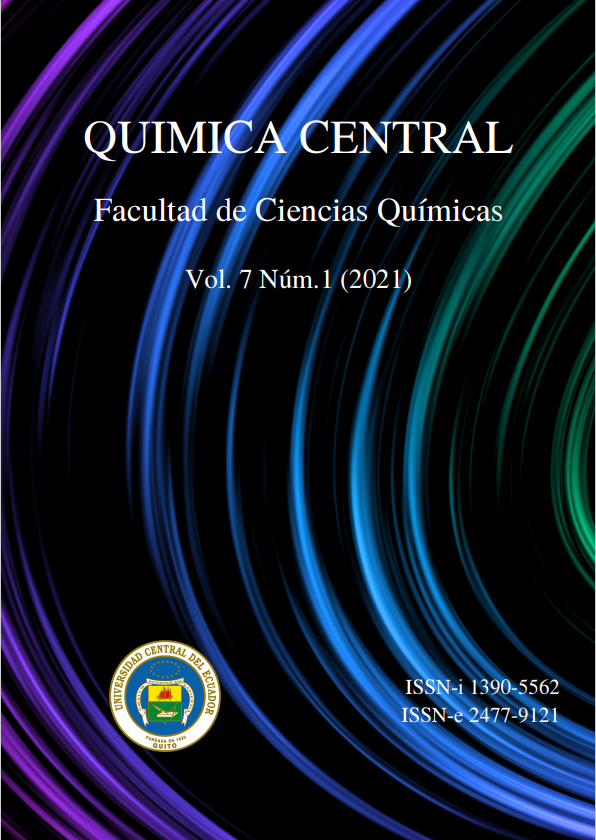In silico study of basic leucine zipper transcription factors of Carica papaya L.
DOI:
https://doi.org/10.29166/quimica.v7i1.2811Keywords:
bZIP, transcription factors, papaya, caricaceaeAbstract
Transcription factors regulate gene expression by interacting directly with DNA. The class of basic leucine zipper factors or bZIP in arabidopsis has 75 members with similar amino acid domains among all its members. In this work, the papaya genome was studied in silico in order to find possible ortholog bZIP genes in papaya. 37 possible sequences were found, the bioinformatics analysis of the sequences was performed. The sequences were grouped and named similarly to the arabidopsis classification. The results presented below could be used to experimentally evaluate the possible biological function of these genes in papaya.
Downloads
References
T. R. Hughes in A Handbook of Transcription Factors, Ed.: T. R. Hughes, Springer Science+Bussiness Media B.V., New York, 2011, pp. 1.
Salgado, H.; Martínez-Antonio, A.; Janga, S. FEBS Lett. 2007, 58, 3499‒3506.
Matys, V.; et al. Nuc. Ac. Res. 2006, 34, D108‒D110.
Hakoshima, T. eLS, 2014, 1–5.
Landschulz, W.H.; Johnson, P.F.; McKnight, S.L. 1988. Science. 1998, 240:1759–64.
O'Shea E.K.; Klemm, J.D.; Kim, P.S.; Alber; T. Science. 1991, 254, 539-44.
Jakoby, M.; Weisshaar, B.: Dröge-Laser, W.; Vicente-Carbajosa, J.; Tiedemann, J.; Kroj, T.; Parcy, F. Trends Plant Sci. 2002, 7, 3, 106‒111.
Ming, R.; et al. Nature. 2008, 452, 24, 991‒996.
Takata, N.: Saito, S.; Tanaka, C.; Uemura, M. BMC Evol. Biol. 2010, 10,126.
Peraza-Echeverria, S.; Santamaría, J.M.; Fuentes, G.; Menéndez-Cerón, M.: Vallejo-Reyna, M.A.; Herrera-Valencia, V.A. Genes Genom. 2012, 34, 4, 379‒390.
Estrella-Maldonado H.; et al. Plant Cell Tiss. Organ Cult. 2016, 126, 2, 187-204.
Estrella-Maldonado, H.; et al. Plant Growth Regul. 2018, 37, 2, 502–516.
Idrovo-Espín, F.M.; Peraza-Echeverria, S.; Fuentes, G.; Santamaría, J.M. Plant Physiol. Bioch. 2012, 54, 113‒122.
Arizala-Quinto, E.; Viteri, G.; Idrovo-Espín, F. J. Basic App. Gen. 2019, 30, 1, 1–3.
Cevallos-Vilatuña T.; Garzón-Salazar K.; Idrovo-Espín F. Rev. Amazónica Ciencia Tec. 2019, 8, 1, 1–11.
Swarbreck, D.; et al. Nuc. Ac. Res. 2008, D1009–14.
Goodstein, D.M.; el al. Nuc. Ac. Res. 2012, D1178‒86.
FGENESH. http://www.softberry.com/berry
phtml?topic=fgenesh&group=programs&subgroup=gfind (accesado 6 de abril 2020).
Kumar, S.; Stecher, G.; Tamura, K. Molec. Biol. Evol. 2016, 33, 7, 1870‒1974.
Santiago-Sotelo, P.; Ramirez-Prado, J. H. BioTechn. 2012, 53, 5, 299–300.
Altschul S. F.; Madden T. L.; Schäffer A. A.; Zhang J.; Zhang Z.; Miller W.; Lipman D. J.; Nucl. Ac. Res. 1997, 25, 3389–3402.
Uno, Y.; Furihata, T.; Abe, H.; Yoshida, R.;Shinozaki, K.;Yamaguchi-Shinozaki, K. Proc. Natl. Acad. Sci. U. S. A. 2002, 97, 11632–11637.
Choi, H.; Hong, J.; Ha, J.; Kang, J.; Kim, S.Y. J. Biol. Chem. 2000, 21, 1723–1730.
Kang, J.; Choi, H.; Im, M.; Kim, S. Plan Cell. 2002, 14, 343‒357.
Yoshida, T.; et al. Plant J. 2010, 61, 672–685.
Yoshida, T.; et al. Plant Cell Environ. 2015, 38, 35–49.
Liu, J.; Srivastava, R.; Howell, S. Plant Cell. 2007, 19, 4111-4119.
Song, Z.T.; Sun, L.; Lu, S. J.; Tian, Y.; Ding, Y.; Liu, J. Proc. Natl. Acad. Sci. U. S. A. 2015, 3, 112, 9, 2900–2905.
Ehlert, A.; Weltmeier, F.; Wang, X.; Mayer, C.; Smeekens, S.; Carbajosa, V.; Lase, W. Plant J. 2006, 46, 890‒900.
Matiolli, C.C.; et al. Plant Physiol. 2011, 157, 2, 692-705.
Kesarwani, M.; Yoo, J.; Dong, X. Plant Physiol. 2007,144, 1, 336‒346.
Gibalova, A.; Renák, D.; Matczuk, K.; Dupl’áková, N.; Cháb, D.; Twell, D.; Honys, D. Plant Molec. Biol. 2009, 70, 581‒601.
Assunçãoa, A.; et al. Proc. Natl. Acad. Sci. U. S. A. 2010,107, 10296–10301.
Hsieh, W.; Hsieh, H.; Wu, S. Plant Cell. 2012, 24, 3997‒4011.
Huang, L.; Zhang, H.; Zhang, H.; Deng, X.; Wei, N. Plant Sci. 2015, 238, 330‒339.
Tsugama, D.; Liu, S.; Takano, T. PLOS One. 2014, 9, 8, e103930.
Rook, F.; Weisbeek, P.; Smeekens, S. Plant Molec. Biol. 1998, 37, 171‒178.
Bowers, J.E.; Chapman, B.A.; Rong, J.; Paterson, A.H. Nature. 2003, 422, 433–438.
Langham, R.J.; Walsh, J.; Dunn, M.; Ko, C.; Goff, S. A.; Freeling, M. Genetics. 2004,166, 2, 935‒945.
Fang, J.; et al. Euphytica, 2016, 209, 323–339
Moitra, J.; Szilák, L.; Krylov, D.; Vinson, C. Biochem. 1997, 36, 41, 12567–12573.
Deppmann, C., Acharya, A.; Rishi, V.; Wobbes, B.; Smeekens, S.; Taparowsky, E.; Vinson, C. Nuc. Ac. Res. 2004, 32, 11, 3435‒3445.
Martínez, M. Comput. Struct. Biotechnol. J. 2013, 8, 10, e201307001.
Downloads
Published
How to Cite
Issue
Section
License
Copyright (c) 2021 Fabio Marcelo Idrovo Espín, Karime Domínguez, Esmeralda Endara

This work is licensed under a Creative Commons Attribution-NonCommercial-NoDerivatives 4.0 International License.
Los originales publicados en las ediciones impresa y electrónica de esta revista QUÍMICA CENTRAL son propiedad de la Universidad Central del Ecuador, siendo necesario citar la procedencia en cualquier reproducción parcial o total.
La propiedad intelectual de los artículos publicados en revista QUÍMICA CENTRAL pertenece al/la/los/las autor/a/es/as, y los derechos de explotación y difusión científica están direccionados para la revista QUÍMICA CENTRAL mediante CARTA DE AUTORIZACIÓN DE PUBLICACIÓN publicada en esta plataforma.


